
|
Glossary Illustrated D |







(alphabetical and illustrated) Introduction | A - 1 | A - 2 | B - 1 | B - 2 | C - 1 | C - 2 | C - 3 | D | E | F G - H | I - J - K | L - M | N - O | P | Q - R | S - 1 | S - 2 | T | U - V - W - X - Y - Z |
|
|
|
|
| the immediately processed, rough cuts, exposed film, or first prints of a film (w/o special effects or edits) for the director (producer, cinematographer, or editor) to review, to see how the film came out after the day's (or previous day's) shooting; more commonly in the form of videotape or digital dailies nowadays; aka rushes (referring to the haste taken to make them available); used to determine if continuity is correct, if props are missing or out of place, or if sound is poor, etc., to help decide whether to re-shoot | ||
| in film terms, a little-known, unlikely movie (often a sleeper, a low-budget film, indie, or a foreign film) that is, surprisingly, nominated for a major award (i.e., Academy Award or Golden Globe) | Examples: Marty (1955), The Accidental Tourist (1988), The Full Monty (1997), and The Pianist (2002) | |
| a cinematographic technique for using shots filmed during the day to appear as moonlit night shots on the screen, by using different lenses, filters, special lighting and underexposure; very common during the 50s and in the 60s, but rarely used in present-day films. |
|
|
| a specific type of comedic device in which the performer assumes an expressionless (deadpan) quality to her/his face demonstrating absolutely no emotion or feeling. | 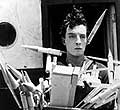 Example: a trademark of Buster Keaton's comedic form, seen here in The Navigator (1924). |
|
| a French term referring to the design of a film - the arrangement of its shots | ||
shot |
a style or technique of cinematography and staging with great depth of field, preferred by realists, that uses lighting, relatively wide angle lenses and small lens apertures to simultaneously render in sharp focus both close and distant planes (including the three levels of foreground, middle-ground, and extreme background objects) in the same shot; contrast to shallow focus (in which only one plane is in sharp focus) |
|
| refers to a scene that was edited out of a film's final cut, for several possible reasons: the scene was poorly done, the scene was unnecessary, the film's running time needed truncation, the film was avoiding an R or NC-17 rating, the film's studio disapproved of it, etc. Deleted scenes are now commonly included on DVDs, either re-edited into a director's cut or as a separate feature | 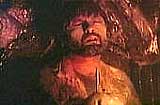 Example:
In Alien (1979), its most famous deleted
scene was the one of Ripley (Sigourney Weaver) discovering the alien's
nest and the bodies of Dallas (Tom Skerritt) and Brett (Harry Dean Stanton),
restored in the Director's Cut release of the film in 2003 Example:
In Alien (1979), its most famous deleted
scene was the one of Ripley (Sigourney Weaver) discovering the alien's
nest and the bodies of Dallas (Tom Skerritt) and Brett (Harry Dean Stanton),
restored in the Director's Cut release of the film in 2003 |
|
| the point immediately following the climax when everything comes into place or is resolved; often the final scene in a motion picture; aka tag; see resolution | ||
| the depth of composition of a shot, i.e., where there are several planes (vertical spaces in a frame): (1) a foreground, (2) a middle-ground, and (3) a background; depth of field specifically refers to the area, range of distance, or field (between the closest and farthest planes) in which the elements captured in a camera image appear in sharp or acceptable focus; as a rule of thumb, the area 1/3 in front of and 2/3 behind the subject is the actual distance in focus; depth of field is directly connected, but not to be confused with focus |  Example:
Extreme depth-of-field in many shots in Citizen
Kane (1941) to heighten dramatic value, achieved by using very
bright lighting and a slightly wide-angled lens by cinematographer Gregg
Toland, causing objects or characters close in the frame's foreground
to appear massive, while other objects appear smaller in the background;
other scenes with extreme depth-of-field include the early snowball scene,
the 'Crash of '29' scene, and Susan's overdose scene Example:
Extreme depth-of-field in many shots in Citizen
Kane (1941) to heighten dramatic value, achieved by using very
bright lighting and a slightly wide-angled lens by cinematographer Gregg
Toland, causing objects or characters close in the frame's foreground
to appear massive, while other objects appear smaller in the background;
other scenes with extreme depth-of-field include the early snowball scene,
the 'Crash of '29' scene, and Susan's overdose scene |
|
| related to depth of field - refers to an adjustment made technically to insure that a camera shot retains its deep focus throughout all the various planes (fore, middle, and back) | Example: Citizen Kane (1941) has many examples of deep-focus shots in which the foreground and background are in focus | |
| literally, the resolution of the plot by the device of a god ("deus") arriving onstage by means of a piece of equipment ("machina") and solving all the characters' problems; usually refers to an unlikely, improbable, contrived, illogical, or clumsy ending or suddenly-appearing plot device that alleviates a difficult situation or brings about a denouement - just in the nick of time; can sometimes refer to an unexpected, artificial, or improbable character |  Examples:
when a poor protagonist unexpectedly receives an inheritance, or when
the cavalry arrives at just the right time to save a beleaguered wagon
train; the Coen Brothers' The Hudsucker Proxy (1994) in which
Moses - a black custodian, fixes the Hollywood firm's clock and predicts
the outcome of events, and the narrator stops the film midstream - during
a suicidal leap - (pictured) and directly addresses the audience; or
the ending of Demons (1985); or the resolution of the plot by
Queen Elizabeth in Shakespeare in Love (1998) Examples:
when a poor protagonist unexpectedly receives an inheritance, or when
the cavalry arrives at just the right time to save a beleaguered wagon
train; the Coen Brothers' The Hudsucker Proxy (1994) in which
Moses - a black custodian, fixes the Hollywood firm's clock and predicts
the outcome of events, and the narrator stops the film midstream - during
a suicidal leap - (pictured) and directly addresses the audience; or
the ending of Demons (1985); or the resolution of the plot by
Queen Elizabeth in Shakespeare in Love (1998) |
|
| any spoken lines in a film by an actor/actress usually based upon a script; may be considered overlapping if two or more characters speak simultaneously; in film-making, recording dialogue to match lip movements on previously-recorded film is called dubbing or looping | See this site's "Greatest Film Quotes, One-Liners, Movie Speeches or Dialogues" of all time | |
(diegesis) |
simply means realistic or logically existing,
such as the music that plays on a character's radio in a scene; more
generally, it refers to the narrative elements of a film (such as spoken
dialogue, other sounds, action) that appear in, are shown, or naturally
originate within the content of the film frame; the opposite is non-diegetic elements,
such as sounds (e.g., background music, the musical score, a voice-over,
or other sounds) w/o an origin within the film frame itself; in an objective
shot, the most common camera shot, it simply presents what is
before the camera in the diegesis of the narrative |
Example: in E.T.: The Extra-Terrestrial (1982), diegetic sounds are heard of the 'keys' men (who drive trucks with glaring headlights) as they approach E.T.'s spaceship, to suggest danger |
| the reduction or softening of the harshness or intensity of light achieved by using a diffuser or translucent sheet (lace or silk) in front of the light to cut down shadows; diffusion materials include screen, glass, filters, gauze, wire mesh, or smoke; also see soft-focus. | ||
| refers to filming on digital video using digital high-resolution cameras, and afterwards, post-production entirely using video editing methods; this technique completely eliminates traditional 35mm film | Example: Star Wars, Episode II: Attack of the Clones (2002) was the first major live-action feature film ever to be shot using digital cinematography - it was a complete digital production from start to finish | |
| in cinematographic terms, using light and dark lighting and frame composition to emphasize what is important within the frame | ||
| the technique of recording sound simultaneously with the recording of the image | ||
(and directing) |
the creative artist responsible for complete artistic control of all phases of a film's production (such as making day-to-day determinations about sound, lighting, action, casting, even editing), for translating/interpreting a script into a film, for guiding the performances of the actors in a particular role and/or scene, and for supervising the cinematography (director of photography) and film crew. The director is usually the single person most responsible for the finished product, although he/she couldn't make a film without support from many other artists and technicians; often the director is called a helmer (at-the-helm); the assistant director is known as the a.d. ; the director of photography (or cinematographer), responsible for the mechanics of camera placement, movements, and lighting, is known as the d.p. |  Example:
director Ernst Lubitsch on the set - see this site's write-up on the "Greatest
Directors" Example:
director Ernst Lubitsch on the set - see this site's write-up on the "Greatest
Directors" |
| a rough cut (the first completely-edited version) of a film without studio interference as the director would like it to be viewed, before the final cut (the last version of the film that is released) is made by the studio. | 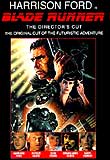 Example:
the director's cut version of Ridley Scott's futuristic adventure, Blade
Runner (1982). Example:
the director's cut version of Ridley Scott's futuristic adventure, Blade
Runner (1982). |
|
| in a film scene, when the moving or panning camera unexpectedly comes upon or 'discovers' an object or person previously undisclosed to the viewer |  Example:
the revelation of cannibalistic Hannibal Lecter in his prison cell in The
Silence of the Lambs (1991) Example:
the revelation of cannibalistic Hannibal Lecter in his prison cell in The
Silence of the Lambs (1991) |
|
or Disney-fied |
refers to the making of an adapted, sanitized, 'family-friendly' version of a book or play, by removing objectionable elements (such as crude language, sexuality, or violence) and modifying plot elements to make the tale more acceptable, entertaining, predictable and popular for mass consumption by audiences, as first exercised by the Disney studios in the 50s; now used as a derogatory term for how popular culture has been homogenized and cultural diversity has been minimized; see also bowdlerize(d) | Examples: Disney's Cinderella (1950) and Sleeping Beauty (1959), and recently Pocahontas (1995) and The Hunchback of Notre Dame (1996); the dark Dickens novel Oliver Twist was remade as a light musical Oliver! (1968) |
(or lap dissolve) |
a transitional editing technique between two sequences, shots or scenes, in which the visible image of one shot or scene is gradually replaced, superimposed or blended (by an overlapping fade out or fade in and dissolve) with the image from another shot or scene; often used to suggest the passage of time and to transform one scene to the next; lap dissolve is shorthand for 'over'lap dissolve; also known as a soft transition or dissolve to; contrast to cross-fade | 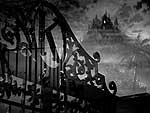 Example:
the many dissolves in the opening sequence of Citizen
Kane (1941) as the camera approaches Kane's Xanadu estate;
also in Metropolis (1927) Example:
the many dissolves in the opening sequence of Citizen
Kane (1941) as the camera approaches Kane's Xanadu estate;
also in Metropolis (1927)  the
dissolves that transform the face of the heroine Maria into the face
of an evil robot; and the transformational dissolves in The Wolf
Man (1941) and The Invisible Man (1933) (pictured); the
dissolves that transform the face of the heroine Maria into the face
of an evil robot; and the transformational dissolves in The Wolf
Man (1941) and The Invisible Man (1933) (pictured); |
| a non-fiction (factual), narrative film with real people (not performers or actors); typically, a documentary is a low-budget, journalistic record of an event, person, or place; a documentary film-maker should be an unobtrusive observer - like a fly-on-the-wall, capturing reality as it happens; aka doc or docu; also called direct cinema; one type is termed docudrama; contrast with cinema verite and mockumentary |  Examples:
a term first coined by John Grierson when describing Robert Flaherty's
(the 'father of the documentary') 'objective' film about the daily life
of a Polynesian youth, Moana (1926); Michael Moore's Roger
and Me (1989) and Morgan Spurlock's Supersize Me (2004): examples
of independent documentaries; 'subjective', propagandistic documentaries
also exist, such as Leni Riefenstahl's Triumph of the Will (1935) Examples:
a term first coined by John Grierson when describing Robert Flaherty's
(the 'father of the documentary') 'objective' film about the daily life
of a Polynesian youth, Moana (1926); Michael Moore's Roger
and Me (1989) and Morgan Spurlock's Supersize Me (2004): examples
of independent documentaries; 'subjective', propagandistic documentaries
also exist, such as Leni Riefenstahl's Triumph of the Will (1935) |
|
|
|
a collective of film directors founded in Denmark in 1995 led by Lars von Trier, with a distinctive democratizing philosophy and set of rules (termed "the vow of chastity") that rejected special effects and contrived lighting/staging and camera work, and espoused returning to more "truthful" and honest, "non-Hollywood" forms of cinema; the ten rules included shooting on location, use of hand-held cameras, natural lighting only, no props, use of digital-video (DV), lack of credits for the director, etc. | 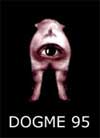 Examples:
Thomas Vinterberg's Festen (The Celebration) (1998), von Trier's
Idioterne (The Idiots) (1998), writer/director Harmony Korine's Julien
Donkey-Boy (1999), Søren Kragh-Jacobsen's Mifune (1999),
Jean-Marc Barr's Lovers (1999, Fr.), Richard Martini's Camera
(2000), Kristian Levring's The King is Alive (2000), Lone Scherfig's
Italian for Beginners (2001, Denmark). Examples:
Thomas Vinterberg's Festen (The Celebration) (1998), von Trier's
Idioterne (The Idiots) (1998), writer/director Harmony Korine's Julien
Donkey-Boy (1999), Søren Kragh-Jacobsen's Mifune (1999),
Jean-Marc Barr's Lovers (1999, Fr.), Richard Martini's Camera
(2000), Kristian Levring's The King is Alive (2000), Lone Scherfig's
Italian for Beginners (2001, Denmark). |
| a stereo-sound process for motion pictures created by Dolby Laboratories, Inc., used to improve sound quality; 35mm prints have two optical sound tracks (Dolby can decode and playback on four channels), while 70mm prints have six magnetic tracks for multi-channel playback; by the 1990s, Dolby Stereo was superceded by advanced digitally-recorded sound | Examples: The first Dolby encoded stereo-optical soundtrack on a feature film was Ken Russell's Lisztomania (1975). Other Dolby stereo soundtracks existed for Star Wars (1977), Apocalypse Now (1979), Close Encounters of the Third Kind (1977), and Superman (1978). | |
|
|
refers to a moving shot in which the perspective of the subject and background is changed; the shot is taken from a camera that is mounted on a simple tripod, or on a hydraulically-powered wheeled camera platform (sometimes referred to as a truck or dolly), pushed on rails (special tracks or dolly tracks) and moved smoothly and noiselessly during filming while the camera is running; the dolly carries the camera equipment and often some of the camera crew - and occasionally the director; a pull-back shot (or dolly out) is the moving back ('tracking back') of the camera from a scene to reveal a character or object that was previously out of the frame, dolly in is when the camera moves closer ('tracking in') towards the subject, and dollying along with (or 'tracking within') refers to the camera moving beside the subject; also known as tracking shot, trucking shot, follow shot, or traveling shot; contrast with zoom shots. |
 Examples:
the first eight minutes of Robert Altman's The Player (1992) was
filmed with a sustained dolly shot, similar to the famous opening sequence
(shown here) of Welles' Touch of Evil (1958); or the opening shot in Boogie Nights (1997) that tracked into the 70s disco, or the shot from the dressing room to the ring in Raging
Bull (1980) Examples:
the first eight minutes of Robert Altman's The Player (1992) was
filmed with a sustained dolly shot, similar to the famous opening sequence
(shown here) of Welles' Touch of Evil (1958); or the opening shot in Boogie Nights (1997) that tracked into the 70s disco, or the shot from the dressing room to the ring in Raging
Bull (1980) |
|
|
a German word literally meaning: "doublewalker," a reference to the fact that a shadow-self, duplicate, counterpart or double (spiritual, ghostly, or real) accompanies every individual |  Examples:
in cinematic use, the contrast between the 'good' and 'evil' side of a person,
as in Hitchcock's Strangers on a Train (1951) between Robert Walker
and Farley Granger (shown in criss-crossing shots of their shoes), or the
'evil' Uncle Charlie (Joseph Cotten) and his 'twin' counterpart - the 'good'
young Charlie (Teresa Wright) in Shadow of a Doubt
(1943); also evidenced in Brian De Palma's Sisters (1973),
Kieslowski's film The Double Life of Véronique (1991), David
Cronenberg's Dead Ringers (1988), and Fight Club (1999) Examples:
in cinematic use, the contrast between the 'good' and 'evil' side of a person,
as in Hitchcock's Strangers on a Train (1951) between Robert Walker
and Farley Granger (shown in criss-crossing shots of their shoes), or the
'evil' Uncle Charlie (Joseph Cotten) and his 'twin' counterpart - the 'good'
young Charlie (Teresa Wright) in Shadow of a Doubt
(1943); also evidenced in Brian De Palma's Sisters (1973),
Kieslowski's film The Double Life of Véronique (1991), David
Cronenberg's Dead Ringers (1988), and Fight Club (1999) |
|
|
refers to the person who temporarily takes the leading player's place for a dangerous or difficult stunt, or to photographically stand in for the actor (when the latter is not available or when the actor wants a body double for a nude scene, etc.) | |
|
|
to expose a single frame twice so that elements of both images are visible in the finished product; produces an effect similar to superimposition and is often used to produce 'ghostly' effects | |
|
|
a comedic convention that refers to the way in which an actor first looks at an object (subject, event, scene, etc.), then looks away, and then snaps his head back to the situation for a second look - with surprise, disgust, sexual longing, etc.; a variation is termed a spit-take (the double-take causes the character to spit out whatever he is drinking) | 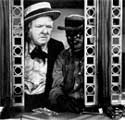 Example:
W.C. Field's double-take at a black bank customer in a teller line in The
Bank Dick (1940) Example:
W.C. Field's double-take at a black bank customer in a teller line in The
Bank Dick (1940) |
|
|
an outdoor movie theatre in which the patrons viewed a film from their automobile; films projected were often B-films or low-budget films; reached their peak in terms of popularity and numbers in the 1970s; also called a passion pit, ozoner; contrast with a hard top (or indoor movie theatre). |
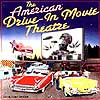
|
|
(or dubbing) |
the act of putting a new soundtrack on a film or adding a soundtrack (of dialogue, sound effects, or music) after production, to match the action and/or lip movements of already-filmed shots; commonly used when films are shot on location in noisy environments; also refers to adding translated dialogue to a foreign-language film; as opposed to direct sound - which is sound recorded when filming a scene; contrast to looping. | |
|
|
the process or technique of combining shots filmed in a studio with background footage shot elsewhere | |
|
(or canted angle) |
a shot made with the camera leaned to one side and filming at a diagonal angle (the horizon is not parallel with the bottom of the frame); see also camera angle. | Examples: in Carol Reed’s The Third Man (1949). |
|
|
a photographic technique used to mask the projected image size and shape to any ratio that seems appropriate for the scene (e.g., the image narrows as an actor passes through a narrow passageway, and then widens as he emerges) | |
|
|
an imaginary, wretched, dehumanized, dismal, fearful, bad, oppressive place or landscape, often initiated by a major world crisis (post-war destruction) coupled with, an oppressive government, crime, abnormal behavior, etc.; the opposite of utopia (a state of ideal perfection); see also nihilism |  Example:
the worlds of Metropolis (1927), Fahrenheit
451 (1966), A
Clockwork Orange (1971), the comedy Sleeper
(1973), The Road Warrior (1982) (aka
Mad Max 2 (1981)), Blade
Runner (1982) (pictured) and 1984 (1984) Example:
the worlds of Metropolis (1927), Fahrenheit
451 (1966), A
Clockwork Orange (1971), the comedy Sleeper
(1973), The Road Warrior (1982) (aka
Mad Max 2 (1981)), Blade
Runner (1982) (pictured) and 1984 (1984) |